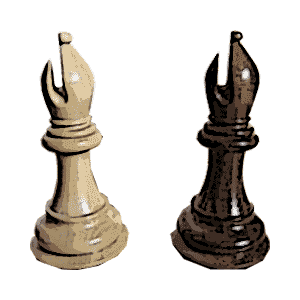Learn The Bishop Moves For Chess

Done playing with the Knight? The Knight tour getting old? Easy. The Bishop moves can provide a change of scenery. The Bishop can support his Queen from the safety of his own camp. His long range control across the board is quite an asset.
There are a couple of different deployment options that you can choose for your Bishops. This basically depends on your playing style or what plan you choose in a game. In many games the King's Bishop will come to the b or c files, the Queen's Bishop will come to the f or g files. The other option is to fianchetto your Bishop. This is done for a more slow burning strategy.
The first thing to cover as always is the initial set-up. The nature of the Bishop's starting position throws up interesting consequences. Your Bishops line up beside the King and Queen as you will see.
Initial Setup
































































Bishop Moves - Each side starts with two Bishops placed on the back row on the third square in
You'll be happy to hear that the Bishop's move is not as tricky as that of the Knight. He basically operates on the diagonals. This means that whatever color square a Bishop starts on, that's the color he will spend the whole game on.
You can see in the diagram that both sides start with one dark square Bishop and one light square Bishop. A Bishop pair can cover the whole board but each individual Bishop is confined to either the light half or the dark half.
As you become more experienced you will see the significance that one Bishop or the other can make to your strategy. In certain circumstances you may find it important to retain a particular Bishop that is crucial to your plans.
Good Bishop vs Bad Bishop
































































Bishop Moves - The Bishop is sometimes good sometimes bad depending on whether it is blockaded by it's own pieces and/or evaded by opposing pieces. In this position the White Bishop is a bad Bishop but the Black Bishop is good
In the endgame a Bishop can sometimes be good or bad. If your pieces are mostly on light squares and your opponents pieces are mainly on dark squares then you want a dark square Bishop. And vice versa.
You don't want your Bishop to acquire the unwanted label of a tall pawn. This is when it ends up in a pawn chain with its own pawns and can't move. It is quite possible in Bishop vs Bishop endgames that both Bishops can be good or bad. If both are bad Bishops then assuming the two sides are evenly matched, it's a drawn position.
If both Bishops are good then it's game on. If the Queens are still on the board, the Bishops can support them from long or close range. Bishops can support Queens in mating attacks from either wing.
Harnessing the Power of the Bishop Pair

Bishop Moves - The Bishops can control key adjacent diagonals
But two comrade Bishops can work together against the enemy, complimenting each others strengths and depreciating the only weakness of the Bishop. A Bishop pair can cover all squares unlike a lone Bishop.
These terrible twins can exert a devastating impact on the enemy forces in a couple of ways. They can control adjacent diagonals as in the diagram to pressurize the fortress of a castled King.
You could also fianchetto both Bishops and control both long diagonals. Your opponent then has to endure their power searing down both these diagonals criss-crossing the board.
Fianchetto the Bishop
































































Fianchettoed Bishops exert power and influence on the long diagonals
Many chess opening systems feature a Bishop developed to the long diagonal. This gives you a measure of control on that important diagonal that your opponent is sure to feel.
Often it is the diagonal leading straight into the position of your opponent's castled King. However in several systems you will set your Bishop up to control the other long diagonal. This is also very useful. The English Opening is a good example of this.
The fianchettoed Bishop becomes more and more influential as the game wears on. As more pieces come off the board, the pressure exerted by the Bishop grows. Your command of the long diagonal can be the pivotal factor in deciding the outcome of the game.
Moving On
































































Rooks rule the files and ranks
Pretty simple really, the Bishops marshall the diagonals. The light-square Bishops on either side are direct opponents as are the dark-square Bishops. A light square Bishop and a dark square Bishop will never interact.
If they are opponents they will never capture one another. If they are comrades they will never protect one another. Take a look at the Bishop Tutorial.
Anyway that's the Bishops. Time to figure out another back row piece. The first of the major pieces. Now it is the turn of the Rook.

